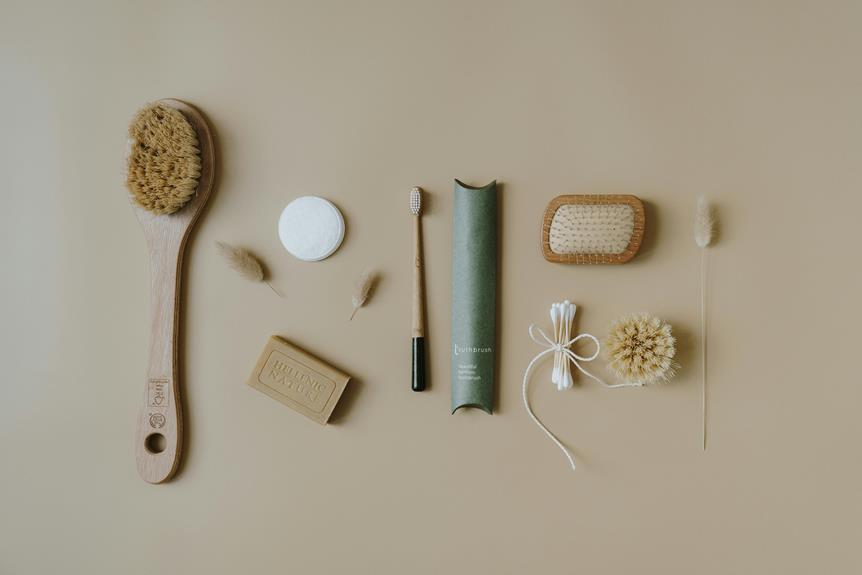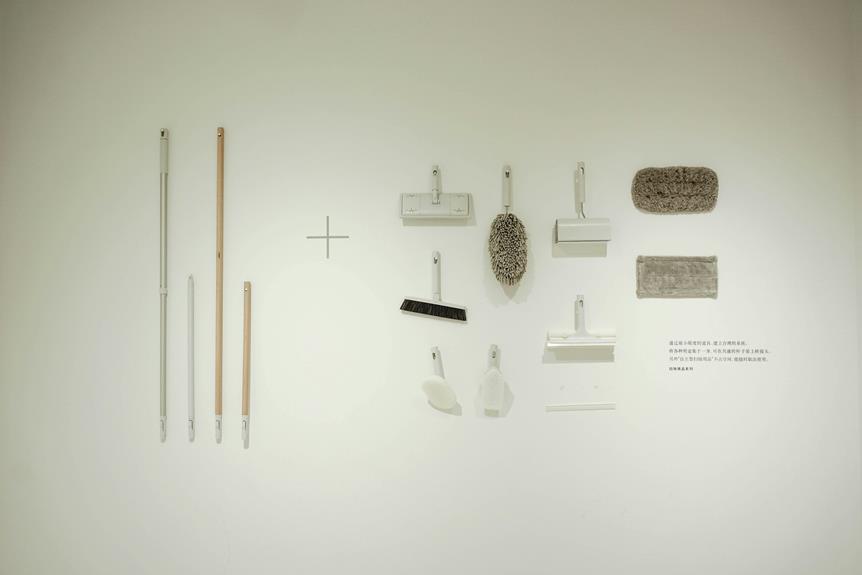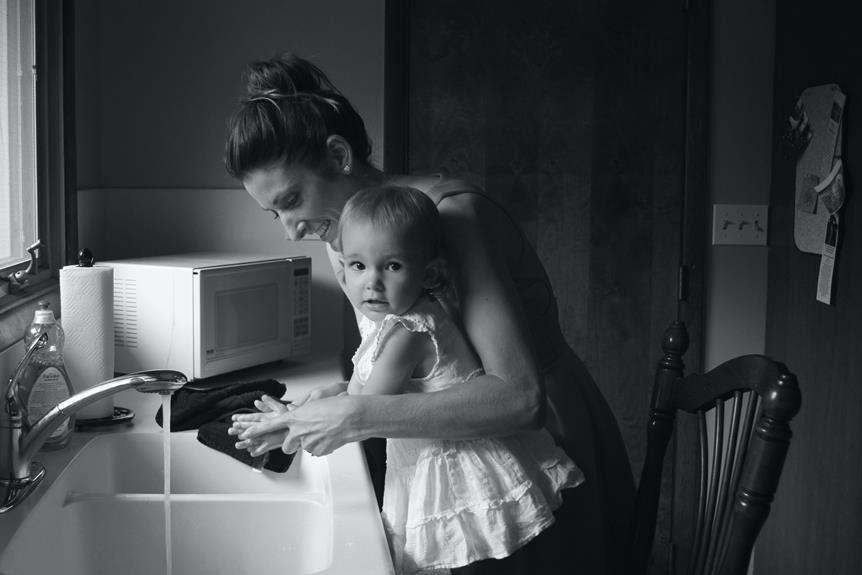Seasonal cleaning can be a challenging task, filled with mixed emotions of anticipation and apprehension. As I stand here amidst the chaos of my cluttered living space, I can’t help but feel a mix of excitement and uncertainty.
It’s time to break free from the chains of bad habits that have accumulated over time. But where do I start? How can I tackle this mess and create a fresh beginning?
In this discussion, I will explore strategies and techniques to help us break free from our bad habits and embrace the transformative power of seasonal cleaning. Together, let’s embark on this journey and discover the path to a cleaner, more organized life.
The Importance of Seasonal Cleaning
Seasonal cleaning is important for maintaining a clean and organized living space. It not only creates a more inviting environment but also offers numerous benefits for your physical and mental well-being.
To make your seasonal cleaning more effective and efficient, follow these simple tips.
Create a cleaning schedule to stay organized and ensure that all areas of your home receive the attention they need. Divide tasks into categories like deep cleaning, decluttering, and organizing. This will help you prioritize and tackle one area at a time.
Organizing your cleaning supplies is also crucial. Having everything in one place saves you time and makes the cleaning process smoother. Consider using bins or caddies to keep your supplies neatly organized and easily accessible.
Deep cleaning is an essential part of seasonal cleaning. It involves thoroughly cleaning areas that are often overlooked in day-to-day cleaning routines, such as behind appliances, inside cabinets, and under furniture. Deep cleaning not only removes dirt and grime but also helps maintain the longevity of your belongings.
Identifying Your Bad Habits
To address your bad habits effectively, take a moment to reflect on your cleaning routine and identify any areas where you may be falling short. Breaking patterns and making positive changes starts with self-reflection. Here are five strategies to help you identify and tackle your bad habits:
- Behavior modification: Take a close look at your cleaning routine and identify the habits that aren’t serving you well. Do you tend to procrastinate or rush through tasks without giving them your full attention? Identifying these patterns is the first step towards breaking them.
- Habit tracking: Keep a journal or use a habit-tracking app to record your cleaning habits. This will help you become more aware of your actions and allow you to see patterns over time. By tracking your habits, you can gain insights into what triggers your bad habits and find ways to overcome them.
- Breaking the cycle: Once you have identified your bad habits, it’s time to break the cycle. Replace negative habits with positive ones. For example, if you often leave dirty dishes in the sink, make it a habit to wash them immediately after use. By consciously making these changes, you can gradually replace old habits with new, healthier ones.
- Seeking support: Changing habits can be challenging, but you don’t have to do it alone. Reach out to friends, family, or online communities for support and accountability. Share your goals and progress with others who’ve similar aspirations. Belonging to a supportive community can provide encouragement and motivation during your journey.
- Celebrating progress: Recognize and celebrate small victories along the way. Breaking bad habits takes time and effort, so it’s important to acknowledge your progress. Treat yourself when you successfully implement new, positive habits into your cleaning routine. By celebrating your achievements, you’ll stay motivated to continue making positive changes.
Setting Clear Goals for Change
Now that you have identified your bad habits and reflected on your cleaning routine, it’s time to set clear goals for change. Clear goal setting is crucial when embarking on a journey of transformation.
Start by defining specific, measurable, achievable, relevant, and time-bound (SMART) goals. Effective planning involves breaking down your goals into smaller, manageable tasks. This will help you stay focused and motivated as you make progress toward your desired change.
Motivation techniques play a vital role in achieving your goals. Find what inspires and drives you to make positive changes in your cleaning routine. Whether it’s envisioning a clean and organized living space or rewarding yourself for accomplishing milestones, these techniques will keep you motivated along the way.
Having accountability partners can greatly enhance your chances of success. Share your goals with trusted friends or family members who can provide support, and encouragement, and hold you accountable. Regular check-ins and discussions about progress can keep you on track and motivated.
Measuring progress is crucial to staying motivated and gauging the effectiveness of your efforts. Set milestones and track your achievements. Celebrate small victories along the way to maintain momentum and reinforce your commitment to change.
Decluttering Your Physical Space
Assess the current state of your physical space and identify areas that need decluttering. Take a moment to look around and see if any spaces are overflowing with items or areas that could use some tidying up. Decluttering your physical space can have many benefits, such as creating a sense of calm and reducing stress.
Here are some techniques and strategies to help you achieve a minimalist lifestyle and optimize your space:
- Start small: Begin by tackling one area at a time. This will prevent overwhelm and allow you to focus on each space effectively.
- Sort and categorize: Create designated areas for different items and group similar things together. This will make it easier to find what you need and maintain order.
- Let go of the excess: Be ruthless when getting rid of items you no longer use or need. Remember, less is more, and decluttering will create more space and freedom in your life.
- Maximize storage solutions: Invest in storage containers, shelves, and organizers to make the most of your space. Utilize vertical storage and hidden spaces like under the bed or behind doors.
- Maintenance is key: Once you have decluttered and organized your space, make it a habit to regularly tidy up and put things back where they belong. This will help maintain a clutter-free environment.
Clearing Out Mental Clutter
Take a moment to simplify your thoughts and emotions and get rid of mental clutter. Clearing out mental clutter is important for improving focus, reducing stress, increasing productivity, and fostering creativity.
Just like physical clutter, mental clutter can weigh you down and make it hard to think clearly and make decisions. By organizing your thoughts and emotions, you can create a calm and clear mental space that’s ready for new ideas and opportunities.
Start by identifying the thoughts and emotions that are occupying your mind.
Are there any recurring negative thoughts causing stress or anxiety?
Are there any unresolved emotions holding you back?
Once you’ve identified this mental clutter, you can begin to let go of it. Practice mindfulness and self-reflection to process and release these thoughts and emotions.
Next, prioritize your thoughts and emotions based on their importance and relevance to your goals and values. Let go of thoughts and emotions that aren’t serving you or contributing to your well-being.
This will help you focus on what truly matters and eliminate distractions.
Breaking the Cycle of Procrastination
To overcome procrastination, it’s important to address the mental clutter that may be contributing to your tendency to put things off. Breaking the cycle of procrastination requires conscious effort and the implementation of effective time management strategies and motivation techniques. Here are five strategies to help you overcome procrastination and achieve your goals:
- Prioritize and create a to-do list: Organize your tasks based on their importance and urgency. Write down your tasks to visualize what needs to be done and prioritize accordingly.
- Break tasks into smaller steps: Large, overwhelming tasks often lead to procrastination. Break them down into smaller, more manageable steps. This will make them feel less daunting and help you stay motivated.
- Set deadlines and stick to them: Establish deadlines for each task to create a sense of urgency and accountability. Be realistic with your deadlines and do your best to meet them.
- Use positive reinforcement: Reward yourself after completing tasks or meeting deadlines. This can be as simple as taking a break or treating yourself to something you enjoy. Positive reinforcement boosts motivation and decreases the likelihood of procrastination.
- Eliminate distractions: Identify and eliminate any distractions that may hinder your productivity. This could include turning off notifications on your phone or finding a quiet workspace.
Establishing New Routines and Rituals
Establishing new routines and rituals is crucial for bringing structure and enhancing productivity in your daily life. By adopting a fresh morning routine, you can start your day positively and set the tone for the rest of the day.
Consider incorporating activities like meditation, journaling, or exercise to invigorate your body and mind. These self-care practices can help you feel centered and focused, enabling you to tackle your tasks effortlessly.
Alongside a morning routine, evening rituals are equally vital for winding down and preparing for a restful night’s sleep. Engage in calming activities such as reading, taking a warm bath, or practicing gratitude to create a serene atmosphere. These rituals will help you relax and detach from the stresses of the day, promoting better sleep and overall well-being.
To stay on track with your new routines, consider using habit trackers. These tools can help you monitor your progress and hold yourself accountable. Whether it’s a physical journal or a digital app, habit trackers allow you to visualize your habits and make adjustments as needed.
If you find it challenging to stick to your new routines alone, consider finding an accountability partner. This person can provide support and motivation, keeping you accountable for your actions and helping you stay consistent with your new habits.
Creating a Supportive Environment
When establishing new routines and rituals, it’s crucial to focus on creating a supportive environment. A nurturing and empowering space can make a significant difference in your personal growth journey and in breaking bad habits. Here are five essential elements to consider when building such an environment:
- Developing positive, supportive relationships: Surround yourself with people who uplift and inspire you. Seek out individuals who believe in your potential and encourage you to achieve your goals.
- Creating a nurturing environment: Fill your surroundings with things that bring you joy and peace. Whether it’s a cozy reading nook or a soothing playlist, ensure that your environment supports your well-being and helps you relax.
- Prioritizing self-care: Make self-care activities a priority to replenish your mind, body, and soul. This could include taking a bubble bath, practicing mindfulness, or indulging in your favorite hobbies.
- Embracing personal growth: Surround yourself with resources and opportunities for personal development. Join a book club, take up a new hobby, or attend workshops that align with your interests and goals.
- Establishing healthy boundaries: Set clear boundaries to protect your time, energy, and emotional well-being. Learn to say no when necessary and communicate your needs effectively.
Embracing a Growth Mindset
Adopting a growth mindset is crucial for personal development and breaking free from negative habits. It means embracing change, seeking personal growth, and shifting your mindset toward self-improvement.
When you have a growth mindset, you believe that with dedication and hard work, you can develop your abilities and intelligence. This mindset encourages you to view challenges as opportunities for growth, rather than obstacles to avoid.
By embracing a growth mindset, you open yourself up to new possibilities and experiences. You become more willing to step out of your comfort zone and take risks to achieve personal growth.
You understand that failure doesn’t define your worth, but rather presents an opportunity to learn and improve. This mindset helps you overcome self-doubt and fear, allowing you to pursue your goals with confidence and resilience.
Embracing a growth mindset also enables you to see setbacks and obstacles as temporary and solvable. Instead of giving up when faced with difficulties, you approach them with a positive and proactive attitude. You understand that setbacks are part of the learning process and that perseverance is key to personal growth.
Letting Go of Toxic Relationships
Breaking free from negative habits requires recognizing and letting go of toxic relationships. Although it’s not easy, it’s necessary for personal growth and well-being. Here are five crucial steps to navigate this process:
- Healing wounds: Toxic relationships can cause emotional pain and leave scars. Take time to prioritize your emotional well-being and heal from these wounds.
- Setting boundaries: Establishing clear boundaries is essential when dealing with toxic relationships. Learn to say no and protect yourself from further harm.
- Self-reflection: Take a step back and reflect on your behavior and patterns in relationships. Understand your role in the toxicity and use this insight to make positive changes.
- Moving forward: Once you’ve recognized the toxicity and taken steps to heal, it’s important to move forward. Surround yourself with positive and supportive people who uplift you.
- Finding closure: Closure is essential to fully let go of toxic relationships. This may involve having honest conversations, forgiving yourself and the other person, and accepting that some relationships aren’t meant to last.
Building Healthy Habits
Now that you have let go of toxic relationships, it’s time to focus on developing healthy habits. Building healthy habits is crucial for personal growth and well-being. It requires strategies for self-discipline, techniques for habit stacking, methods for habit tracking, and creating accountability.
Self-discipline is key to building healthy habits. It involves setting clear goals and sticking to them, even when it’s challenging. By practicing self-discipline, you can establish a routine that promotes positive habits and eliminates negative ones. For example, if you want to start exercising regularly, commit to a specific time each day and stick to it.
Another effective strategy is habit stacking. This technique involves attaching a new habit to an existing one. For instance, if you want to read more books, make it a habit to read a few pages before bed. By linking the new habit to an established one, it becomes easier to remember and integrate into your daily routine.
Tracking your habits is essential for measuring progress. Use a habit tracker app or a simple notebook to monitor your daily activities. This will help you stay accountable and motivated, as you can visually see your progress and identify areas for improvement.
Creating accountability is also crucial for building healthy habits. Share your goals with a trusted friend or family member who can provide support and encouragement.
Consider joining a community or group that shares similar aspirations. Being part of a community that values healthy habits will foster a sense of belonging and provide the necessary support to stay on track.
Finding Balance and Prioritizing Self-Care
Maintaining a healthy balance and prioritizing self-care is crucial for our overall well-being and stress reduction. In our fast-paced world, it’s easy to neglect ourselves and put our needs aside. However, taking the time to care for ourselves is essential for our physical, mental, and emotional health. Here are some self-care tips to help you find balance and prioritize your well-being:
- Establish a self-care routine: Create a regular practice of activities you enjoy, such as meditation, journaling, or going for a walk. Consistency is key to making self-care a priority.
- Set boundaries: Learn to say no to activities or commitments that drain your energy or overwhelm you. Setting boundaries allows you to focus on what truly matters and helps you avoid burnout.
- Be kind to yourself: Practice self-compassion and treat yourself with the same love and care you’d give to a friend. Embrace imperfections and celebrate your achievements, no matter how small.
- Take care of your physical health: Prioritize your physical well-being by nourishing your body with nutritious food, getting enough sleep, and engaging in regular exercise. Remember, self-care encompasses all aspects of your health.
- Seek support: Don’t hesitate to reach out for help when needed. Connect with loved ones, join support groups, or seek professional guidance. Surrounding yourself with a supportive network can make a significant difference in your overall well-being.
Cultivating a Positive Mindset
Developing a positive mindset is crucial for resilience and embracing life’s challenges. In a world filled with negativity, it’s important to actively work on cultivating a positive outlook. One powerful technique for this is using positive affirmations.
Another effective practice is gratitude. Taking a few moments each day to reflect on what you’re grateful for can shift your perspective and cultivate contentment. Whether it’s a warm cup of coffee in the morning or the support of loved ones, expressing gratitude brings fulfillment and happiness.
Visualization techniques can also help cultivate a positive mindset. Self-reflection exercises offer an opportunity for introspection and growth. By examining your thoughts and behaviors, you can identify negative patterns and replace them with positive ones.
Practicing mindfulness is another valuable tool for cultivating positivity. By being fully present in the moment and observing thoughts and feelings without judgment, you can cultivate inner peace and positivity.
Overcoming Fear and Resistance
To overcome fear and resistance, you need to confront your inner doubts and step outside your comfort zone. It’s natural to feel anxious about facing challenges and conquering doubts, but it’s important to remember that growth and transformation come from embracing these fears head-on.
Here are five key strategies to help you overcome fear and resistance:
- Push through obstacles: When faced with resistance, don’t let it hold you back. Instead, push through the obstacles and keep moving forward. Embrace the discomfort and use it as motivation for your personal growth.
- Embrace change: Change can be intimidating, but it’s often necessary for personal development. Challenge yourself to embrace change and see it as an opportunity for growth. Embracing new experiences and perspectives can lead to exciting opportunities.
- Question your limitations: Take a moment to challenge your beliefs and question the limitations you’ve placed on yourself. Often, we underestimate our true potential. By questioning these limitations, you can open yourself up to new possibilities and achieve more than you ever thought possible.
- Find inner strength: Building confidence is crucial in overcoming fear and resistance. Seek out your inner strength and believe in yourself. Remember, you’re capable of great things.
- Seek support: Don’t be afraid to reach out for support. Surround yourself with positive influences who believe in your abilities. Seek guidance from mentors, friends, and family who can provide encouragement and help you navigate through challenging times.
Tracking Your Progress and Celebrating Wins
It’s important to keep tabs on your achievements and take time to acknowledge your successes as you work towards breaking bad habits. By holding yourself accountable through tracking, you can stay focused on your goals and overcome setbacks.
Start by setting clear and measurable targets. Break down your larger goals into smaller milestones that you can regularly track. This will help you monitor your progress and make any necessary adjustments along the way. Keep a journal or use a habit tracker app to record your daily actions and measure your success.
Remember to celebrate even the smallest wins. Recognize and reward yourself for each achievement, no matter how small. Celebrating your accomplishments won’t only boost your motivation but also reinforce the positive behaviors you’re trying to develop.
Don’t let setbacks discourage you. They’re a normal part of the process. Use setbacks as opportunities to learn and adapt your strategies. Reflect on what went wrong and find ways to overcome obstacles. Remember, every setback is a chance to grow stronger and more resilient.
Creating accountability is crucial for staying on track. Share your goals and progress with a friend, family member, or support group. Their encouragement and support will keep you motivated and committed to your journey.
Maintaining Your Fresh Start for the Long-Term
Maintaining your fresh start for the long term requires consistent effort and a commitment to lasting change. Change isn’t a one-time event, but an ongoing process. Here are five key strategies to help you maintain your fresh start and continue on your journey to personal growth:
- Stay motivated: Find ways to keep your motivation high, such as setting goals, visualizing your success, or reminding yourself of the benefits of your progress.
- Be consistent: Consistency is key to long-term success. Create a routine that supports your goals and stick to them. Small, consistent actions will add up over time.
- Avoid relapse: Recognize your triggers and develop strategies to avoid falling back into old habits. Stay mindful of your progress and the reasons why you wanted to make a change in the first place.
- Seek support: Surround yourself with a supportive community or find a mentor who can provide guidance and encouragement. Share your journey with others who understand and can offer valuable insights.
- Adapt to change: Change is inevitable, and being able to adapt is crucial for long-term success. Embrace flexibility and be open to adjusting your plans as needed.
Conclusion
You’ve conquered the dust bunnies, tackled your bad habits, and cleared out the clutter in both your physical and mental spaces.
Your fresh start is shining brighter than ever! With your positive mindset and determination, there’s no stopping you.
Remember, a little seasonal cleaning can lead to big transformations













